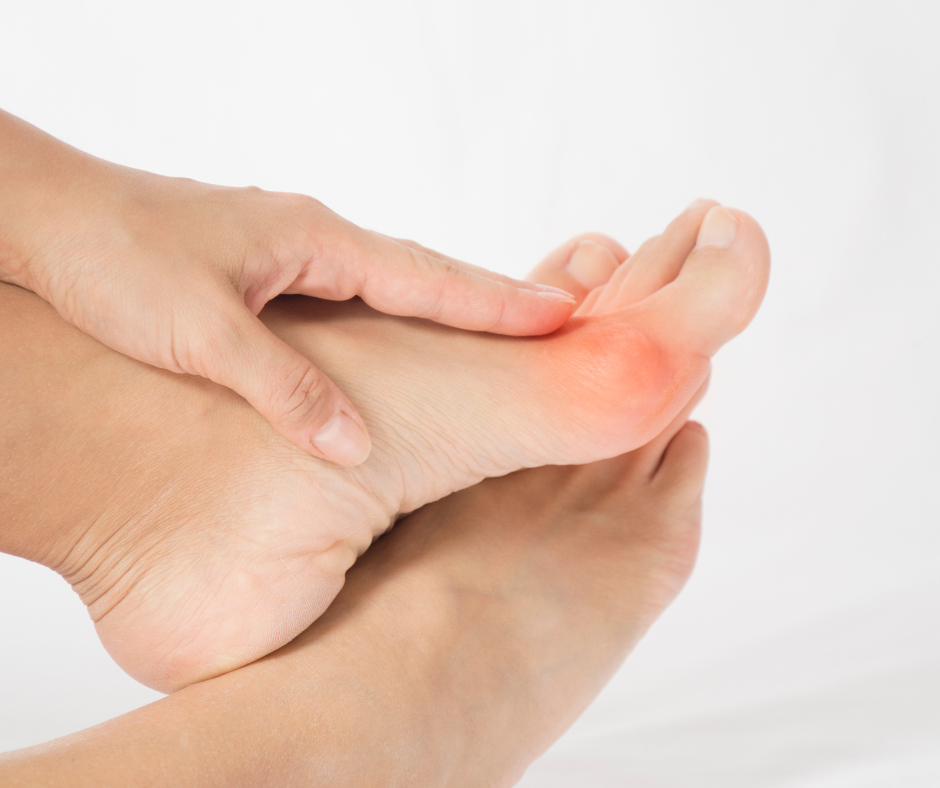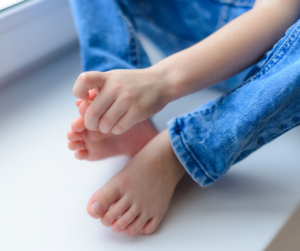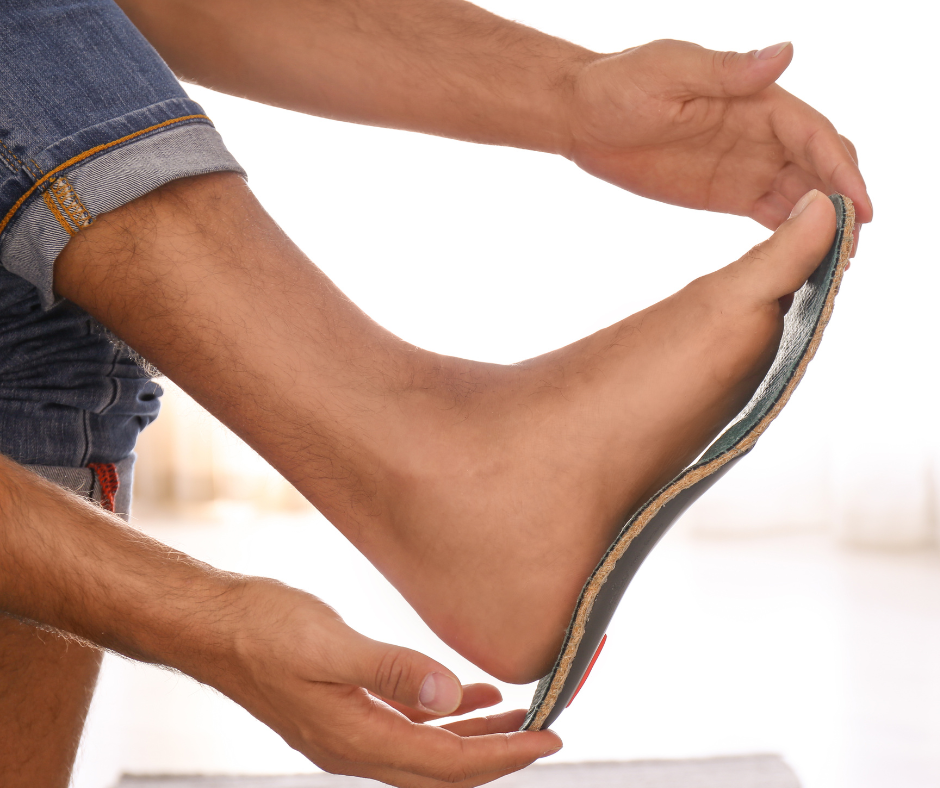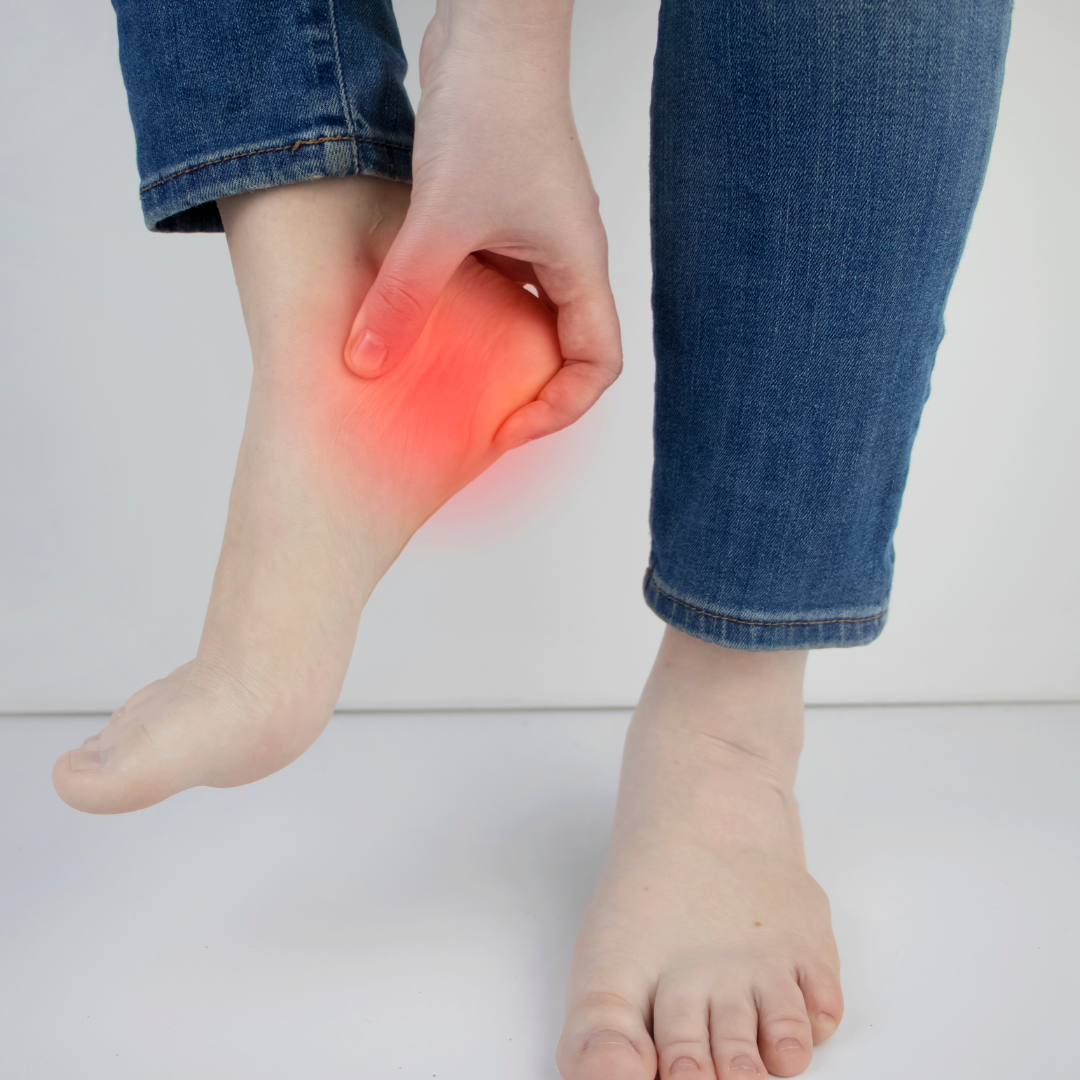-
5 Ways Diabetes Impacts Your Feet

So, you have diabetes, but you’ve never really considered the impact it can have on your feet. We at Kentlands Foot and Ankle Center love treating people with diabetes and educating them on the importance of proper foot hygiene and management. Today, we’ll be talking about the 5 main foot issues that chronically high blood sugar could lead to.
Peripheral Neuropathy
One of the most significant dangers is peripheral neuropathy, which is nerve damage caused by consistently high blood sugar levels over time. Tingling, burning pain, numbness- you might not feel a small cut from stepping on something, a blister from old shoes, or even the constant pressure of a poorly placed seam in a sock. Without the warning signal of pain, these minor injuries can worsen right under your nose.
Peripheral Artery Disease
Diabetes also frequently contributes to Peripheral Artery Disease, which is where the arteries in the legs and feet narrow due to plaque buildup. High cholesterol can reduce blood flow to the lower extremities.
And when circulation is compromised, your feet feel cold, your legs ache and cramp when walking, and most dangerously, the body’s ability to heal is impaired. Even a small wound or infection on the foot can struggle to receive the oxygen and nutrients needed for healing, which raises the risk of it becoming chronic and non-healing.
Foot Deformities
This combination of nerve damage and reduced circulation can also lead to structural changes in the feet. When the muscles weaken, it leads to imbalances and gait issues that result in foot deformities like bunions, hammertoes, or even the devastating collapse seen in Charcot foot.
These deformities then create abnormal pressure points on the foot, and coupled with impaired sensation, they can continuously rub against your shoes without you even feeling it. Yet another risk for blisters and cuts.
Infections
High blood sugar levels can also weaken your immune system, which can make a diabetic more vulnerable to getting sick. This weakened defense, coupled with reduced blood flow and neuropathy, creates a perfect storm.
What might be a simple cut for someone else can quickly escalate into a severe fungal infection for a diabetic.
Diabetic Foot Ulcers
All these factors can culminate in the development of a diabetic foot ulcer – an open sore that penetrates through the skin. These ulcers are the most serious threat, as they can become infected, lead to deep-seated bone infections, and tragically, are the leading cause of lower limb amputations in people with diabetes.
Manage Your Diabetes
The dangers of diabetes for foot health are significant. Proactive daily foot checks, choosing appropriate footwear, and regular visits to a podiatrist are not just recommendations; they are vital steps in preventing these life-altering complications and preserving mobility.
Interested in learning more? Schedule a comprehensive foot examination with Kentlands Foot and Ankle Center podiatrist Dr. Jon M. Sherman. To make your appointment, please call our office at 301-825-9697.
-
Bunion Basics: Understanding That Bump on Your Foot

It’s a typical day…until you put on your shoes. That’s when you notice a bony bump forming at the base of your big toe. What is it? How did it get there? And why does it seem to be “drifting” towards your second toe?
If this sounds familiar, you might be dealing with a bunion, medically known as Hallux Valgus. To keep you informed on why bunions form and what to watch for, Kentlands Foot & Ankle Center is breaking down the basics below.
What’s a Bunion?
A bunion isn’t just an overgrowth of bone. It represents a change in the actual bony framework of the front part of your foot.
- The long bone connected to the big toe (the first metatarsal) starts to drift outward, and the big toe itself begins to point inward towards the smaller toes.
- This misalignment creates the characteristic bump on the side of the foot at the base of the big toe.
Bunions are often progressive, meaning they tend to get worse over time if not managed appropriately.
Why Do Bunions Form?
While ill-fitting footwear gets a lot of blame, the primary cause of bunions is usually:
- Heredity: The biggest factor! Certain inherited foot types and faulty foot mechanics (like excessive pronation or flat feet) make you more susceptible to developing bunions. If your parents or grandparents had bunions, you might be more likely to develop them, too.
- Foot Structure & Biomechanics: The way your foot functions when you walk can place abnormal stress on the big toe joint, contributing to the deformity over time.
- Footwear (The Aggravator): While usually not the root cause, shoes that are tight, narrow, or have high heels can definitely aggravate an existing bunion and potentially accelerate its progression. They force the toes into an unnatural position.
Less common causes can include foot injuries or certain types of arthritis.
Spotting the Signs: Bunion Symptom Checklist
How do you know if that bump is truly a bunion? Look for these common signs:
- The Bump: A bony prominence on the side of your foot at the base of the big toe.
- Toe Drift: Your big toe angling towards your second toe.
- Pain or Soreness: Discomfort around the big toe joint, often worse when wearing shoes or after activity.
- Redness & Swelling: Inflammation around the bony bump.
- Corns or Calluses: These can develop on the bump itself, between the big and second toes, or even on the ball of the foot due to altered pressure.
- Restricted Motion: Decreased flexibility or stiffness in your big toe joint.
- Difficulty Fitting Shoes: Finding shoes that are comfortable and don’t irritate the affected area.
Diagnosis Matters!
Even if your bunion isn’t causing significant pain yet, early evaluation allows us to confirm the diagnosis, rule out other conditions, and plan the best course of treatment for your unique needs. Affected? Don’t suffer in silence. Schedule your appointment and move toward relief today!
Interested in learning more? We’re always happy to help! Schedule a comprehensive foot examination with Kentlands Foot & Ankle Center podiatrist Dr. Jon M. Sherman. To make your appointment, please call our office at 301-825-9697.
-
5 Common Foot and Ankle Injury Myths in Sports

From little league to professional sports, foot and ankle injuries are some of the most common among athletes. And unfortunately, many misconceptions and myths surround these issues, which can hinder recovery.
In this post, we will debunk these myths to help athletes better address their foot and ankle troubles.
Myth 1: All Ankle Sprains Are the Same.
Fact: Ankle sprains vary in severity, ranging from mild to severe. While most ankle sprains involve the ligaments on the outside of the ankle, some can also affect the ligaments on the inside. That’s why you should seek a medical evaluation to determine the extent of the injury.
Myth 2: You’re Right, Coach. I’ll Rub Some Dirt on It.
Fact: Continuing to play with pain can worsen an injury and delay recovery. If you experience pain in your foot or ankle, it’s important to rest and seek medical attention. Overuse injuries and stress fractures are common for athletes who are too stubborn to stop.
Myth 3: Rest Or Surgery. There’s No In Between.
Fact: While rest is often recommended for minor injuries and surgery is sometimes required for season-ending injuries, there lies a full spectrum of intervention between these two extremes:
- Physical therapy: Exercises to strengthen the surrounding muscles and improve stability.
- Corticosteroid injections: These injections can help reduce inflammation and pain in the affected joint.
- Anti-inflammatory medications: Over-the-counter or prescription medications can help alleviate pain and reduce inflammation.
- Orthotics: Custom orthotics may be necessary to address underlying foot mechanics.
Myth 4: All Foot Pain is Caused by Plantar Fasciitis.
Fact: While plantar fasciitis is a common cause of foot pain in athletes, it’s not the only possibility. Other conditions, such as Achilles tendonitis, turf toe, neuromas, and others listed above, can cause pain and limit performance.
Myth 5: Once an Injury Heals, You’re Good to Go.
Fact: Even after an injury heals, it’s important to continue rehabilitation exercises to prevent re-injury. Strengthening the surrounding muscles and improving flexibility can help enhance stability and reduce the risk of recurrence.
Want to start taking your foot and ankle health seriously? We’re happy to help! Schedule a comprehensive foot examination with Kentlands Foot and Ankle Center podiatrist Dr. Jon M. Sherman. To book your appointment, please call our office at 301-825-9697.
-
Don’t Lose Your Mojo: Signs, Symptoms, and Treatments for Broken Toe

If you’ve ever dropped something on your foot or jammed it on something hard, you might have been close to breaking your toe. Broken toes are one of the most common breaks in the human body, and they can be seriously painful injuries that require prompt and careful rehabilitation.
That’s why at Kentlands Foot and Ankle Center, we are here to un-stub the toe fracture confusion, providing expert insight and advice along your path to better foot health.
Signs and Symptoms of a Broken Toe
Because a broken toe often causes immediate and severe pain, it’s helpful to distinguish it from other potential foot injuries like turf toe and toe sprains:
- Intense pain: Sharp and localized pain at the point of impact.
- Swelling: Rapid onset of swelling around the injured toe.
- Bruising: Discoloration may appear within a few hours.
- Deformity: The toe may appear visibly crooked or misshapen.
- Difficulty walking: Putting weight on the injured foot may be painful.
Prognosis for a Broken Toe
Most toe fractures typically heal within 4-6 weeks. However, the specific recovery time can vary depending on the severity of the fracture and the person’s overall foot health.
While most broken toes heal without complications, there is a small risk of developing arthritis in the affected toe in the future. Additionally, if the fracture is not properly aligned, it may result in long-term pain or deformity.
Treatment and Recovery
Most minor toe fractures can be treated at home with the RICE method (rest, ice, compression, elevation) and over-the-counter pain relievers prescribed by your podiatrist. In some cases, your podiatrist may recommend taping or splinting the toe to immobilize it and promote healing.
Crutches or boots are typically not necessary for a broken toe unless there are multiple fractures or associated injuries. However, it’s essential during recovery to avoid putting excessive weight on the injured foot. Physical therapy may also be recommended to gently regain strength and flexibility after the bone has healed.
Want to stay on top of your foot and ankle health this summer? We’re happy to help! Schedule a comprehensive foot examination with Kentlands Foot and Ankle Center podiatrist Dr. Jon M. Sherman. To schedule your appointment, please call our office at 301-825-9697.
-
Protect Your Feet from the Summer Sun

Just like the rest of your body, your feet are susceptible to sun damage. UV rays penetrate the layers of your skin, causing sunburn, premature aging, and increasing the risk of cancer. While the soles of your feet have thicker skin, the tops and ankles are vulnerable, especially for people who wear sandals or flip-flops regularly.
If we diligently protect our faces and arms with sunscreen, why should we neglect our feet? Here’s why you shouldn’t forget about protecting them from the sun’s harmful UV rays, according to our expert team at Kentlands Foot and Ankle Center.
The Risks of Sun-Exposed Feet
- Actinic Keratosis: These precancerous lesions appear as rough, scaly patches on skin exposed to the sun, especially during summer. While not cancerous themselves, they can develop into skin cancer if left untreated.
- Squamous Cell Carcinoma: This is a type of skin cancer that can develop on the sensitive areas of the feet. Early detection can decrease the risk of complications, so be aware of any changes in the appearance of your skin, such as new moles, persistent scaling, or bleeding.
- Age spots: These are flat, brown spots that commonly appear on sun-exposed areas, including the tops of the feet. While benign, they can be a cosmetic concern for some.
- Pre-existing skin conditions: Sun exposure can worsen existing skin conditions on the feet, such as eczema or psoriasis, leading to increased itching, inflammation, and discomfort.
Protecting Your Feet This Summer
- Sunscreen: Apply broad-spectrum sunscreen with SPF 30 or higher to the tops of your feet and ankles 15 minutes before sun exposure. Reapply every two hours, especially after swimming or sweating.
- Sun-Protective Footwear: Wear closed-toe shoes or sandals with straps that cover the tops of your feet. Look for materials like canvas or mesh that allow for ventilation while providing some sun protection.
- Examine Your Feet Regularly: Pay attention to any changes in the appearance of your skin, such as new moles, discolored spots, or changes in texture. If you notice anything concerning, consult a podiatrist.
Want to keep your feet happy and healthy this summer? We’re eager to help! Schedule a comprehensive foot examination with Kentlands Foot and Ankle Center podiatrist Dr. Jon M. Sherman. To schedule your appointment, please contact our office at 301-825-9697.
-
For Foot and Ankle Pain, Tailored Treatments Offer the Best of Both Worlds

Foot pain can sideline even the most active individuals, but before you resign yourself to chronic discomfort, consider the wide variety of treatments available from your local podiatrist. With options ranging from the conservative to the innovative and everything in between, a DPM can restore balance and mobility while managing pain.
The key is finding the right approach for your specific needs! For this blog, the team at Kentland’s Foot and Ankle Center wants to keep you posted on a few of the most effective ones. Read on to learn more about the options available to you, from exciting newbies to tried-and-true standards.
Starting Simple: Rest, Therapy, and Orthotics
The first line of defense is often the simplest.
- Rest, ice, and pain medication might provide relief in the short term.
- Physical therapy strengthens supporting muscles and improves flexibility, addressing the root cause of pain and preventing future problems.
- Custom orthotics deserve special mention. By providing personalized support and correcting biomechanical imbalances, they can significantly improve comfort and function.
You can get the best of both worlds via a combined approach: A 2023 study published in the Journal of the American Podiatric Medical Association (JAPMA) found that physical therapy combined with custom orthotics was highly effective in reducing pain and improving function in patients with plantar fasciitis.
- High-tech and low-tech can also complement one another. For example, our team utilizes 3D orthotic scanning technology to create orthotics tailored to your unique foot shape.
- This ensures a superior fit and function compared to traditional casting methods.
Stepping Up: Advanced Techniques for Persistent Pain
If conservative measures don’t provide lasting relief, your podiatrist might recommend more advanced interventions.
- Shockwave therapy, for instance, utilizes sound waves to stimulate tissue healing and reduce inflammation.
- Studies have shown promise for its effectiveness in treating plantar fasciitis and Achilles tendonitis.
Sometimes, a minimally invasive surgical procedure might be the best approach.
- Many podiatrists are skilled surgeons, able to perform procedures like bunionectomy or hammertoe correction with minimal scarring and downtime involved.
Are you interested in learning more? We’re always happy to help! Schedule a comprehensive foot examination with Kentlands Foot and Ankle Center podiatrist Dr. Jon M. Sherman. To make your appointment, please call our office at 301-330-5666.
-
Keep Your Feet Flowing: Blood Flow and Circulation in the Lower Extremities

February is American Heart Month, a timely reminder to prioritize our cardiovascular well-being. However, while most focus remains on the heart itself, its connection to our feet and lower extremities tends to go unnoticed.
The truth is that healthy blood flow and circulation are crucial for happy, healthy feet. Let the team at Kentlands Foot & Ankle Center delve into this vital relationship for you! Together, we’ll explore how to keep your feet flowing freely.
Heart Health Basics
Your heart pumps tirelessly and constantly, sending oxygen-rich blood throughout your body. But that doesn’t mean there aren’t any problems.
- In terms of distance, your heart works hardest to send blood to your feet, which are as far away from it as possible.
- When this intricate system functions well, your feet receive the nutrients they need to stay healthy and function optimally.
- When something goes amiss, your feet are typically the first to find out.
When the Flow Filters
Disruptions to your circulation tend to translate into problems for your feet.
- Conditions like peripheral artery disease (PAD) – which affects nearly 34 million Americans – narrow arteries, restricting blood flow to the lower extremities.
- This can lead to symptoms such as pain, numbness, and even tissue damage in severe cases.
Circulation Education
Fortunately, several measures can promote healthy blood flow and circulation in your feet:
- Regular exercise, including walking, improves circulation throughout your body, including your lower extremities.
- Avoid tight shoes that constrict blood vessels in your feet.
- If you have diabetes or high blood pressure, work with your doctor to manage these conditions effectively.
- Consult a podiatrist promptly for any concerns like pain, numbness, or changes in skin color or texture.
When in doubt, it never hurts to consult a DPM with a proven reputation for knowing how to handle all kinds of foot and ankle complications!
Schedule a comprehensive foot examination with Kentlands Foot and Ankle Center podiatrist Dr. Jon M. Sherman. To make your appointment, please call our office at 301-330-5666.
-
An Ounce of Prevention is Worth a Pound of Cure with Diabetes

When it comes to the diabetes epidemic, podiatrists are on the front lines. That’s why an expert DPM knows better than most that diabetes can seriously harm your feet. Recent statistics paint a troubling picture: The CDC asserts that nearly 39 million people, or 11.6 percent of the US population, currently have diabetes, with almost 9 million of those as yet undiagnosed. Millions more are pre-diabetic, and that number only becomes grimmer as people age.
Individuals with diabetes are at a higher risk of developing foot complications like neuropathy, poor circulation, and foot ulcers. From there, problems can get even worse. That’s why podiatric care is essential for anyone managing this disease. Check out a few of the helpful tips below, courtesy of Kentlands Foot & Ankle Center.
If you’re a diabetic, see a podiatrist regularly!
- Everyone with diabetes should have an annual exam, no matter what. But for some patients, even more visits will be required.
- Medicare will permit most people to schedule an appointment every two months to care for their nails and calluses. Take advantage of that, and try to stay consistent with your efforts.
Check your feet twice a day!
- Look for the unusual – cuts, redness, anything.
- If you see something, contact us right away.
- Don’t try to handle the problem yourself; you might risk infection or further complications.
DON’T GO BAREFOOT!
- As a diabetic, you always want to protect your feet.
- Wound healing is a dangerous issue, and even minor cuts can harm you more than you think.
- Wear shoes at all times!
Don’t let your diabetic foot care problems get out of hand. It’s important to take action right away if you notice anything amiss. We encourage residents of Montgomery County to consult Dr. Sherman sooner rather than later for a complete examination and assessment of diabetic foot health complications. Call 301-330-5666. or contact us online for an appointment at our Gaithersburg podiatry office. We look forward to getting you back on your feet and keeping you there!
-
Running Shoes: Start Off on The Right Foot!

If you run, you need the right footwear. Fortunately, Kentlands Foot and Ankle Center is well-prepared to support your footwear needs. Before you decide which shoe is right for you, let’s break down some common tips that can improve performance and ensure sustainability.
Here are some Do’s and Don’ts to follow before purchasing new running shoes
DON’T run in old, beat-up shoes. Runners need to be prepared, and footwear is no exception. To keep shoes fresh, try to have two pairs on hand and alternate them. The wear and tear from repeated motions erodes the support of a running shoe, which might increase your risk of injury.
DO invest in a pair of good socks and laces. The right pair of socks will provide valuable cushioning and even help with sweating. Laces with ‘bumps’ along them might cost a little more, but they don’t slide around in your shoes.
DON’T ignore the unique traits of your feet. Do you have high, flat, or neutral arches? Do your ankles roll when you run? These are the kinds of details our experts can help you with, and knowing about them beforehand will help you choose the right shoes for you.
DO consider custom orthotics. These can enhance your running game by helping to prevent injuries before they occur. And we can help you find the perfect fit! At Kentlands, there are no more clunky plaster casts or lengthy waiting times. Instead, we employ our new 3D laser scanner to perform a clinical examination of your feet. In just 10 seconds, this technology takes thousands of measurements and provides the perfect custom fit.
We’re big fans of running, and we know just how much it can benefit your life. Still, putting safety first is important. Dr. Jon Sherman is an acknowledged expert in treating sports injuries, and he has served as a consultant for the Marine Corps Marathon. He’s well-equipped to help improve your athletic performance and keep your feet healthy as you chase your goals. To schedule a comprehensive foot examination with Dr. Sherman at our Gaithersburg office, please call 301-330-8971 or contact us online today.
-
Good News for People with Chronic Heel Pain!

A twitch of pain somewhere in your foot is one thing – brief and tolerable. Thank goodness it goes away.
Heel pain that doesn’t go away is an entirely different matter. We’re talking about the heel pain that greets you like a knife when you step out of bed every morning. The kind of intense pain that makes you cry out, perhaps with a few choice words you didn’t mean to say. This kind of pain requires attention from Kentlands Foot and Ankle Center’s board-certified podiatrist, Dr. Jon M. Sherman, because it’s not likely to get better on its own.
Plantar fasciitis, explained!
The medical term for chronic heel pain is plantar fasciitis. Any medical word with the suffix “-itis” means “inflammation.” In this case, it’s the plantar fascia that’s inflamed. The plantar fascia is a large, thick ligament that runs along the bottom of your foot, connecting the calcaneus (heel bone) to your toes. It’s easily inflamed under some circumstances:
- You have a job that requires you to be on your feet for much of the day, such as a waiter, nurse, or urban mail carrier.
- You’re a runner or walker who’s recently increased their mileage, pace, or distance.
- You participate in other athletic activities, such as ballet, that put a lot of stress on your feet.
- You’re carrying some extra pounds, which puts undue stress on your feet.
- You have pre-existing issues with your foot anatomy, such as flatfoot or high arches.
- You’re over 40: The older you are, the more likely you will develop plantar fasciitis.
The pain you don’t have to live with
Fortunately, we have many effective treatments that soothe the pain of plantar fasciitis. Dr. Sherman will likely start with conservative approaches, including taking a break from any activity that hurts, performing stretching exercises, icing, taking anti-inflammatory medications, wearing custom orthotics, and getting steroid injections. Often, the best treatment involves a combination of all these.
Other treatment options include non-invasive shockwave therapy (ESWT, laser light therapy/cold laser, and physical therapy. Surgery for plantar fasciitis is a possibility but not a common one.
The key to successful plantar fasciitis treatment is getting it promptly. Don’t wait. We encourage residents of Montgomery County to consult Dr. Sherman sooner rather than later for a full examination and assessment of their heel pain. Call 301-330-5666 or contact us online for an appointment at our Gaithersburg podiatry office.
RECENT POSTS
categories
- Uncategorized
- Featured Articles
- Foot Disorders
- Broken Ankle
- Broken Toe
- Fracture
- Foot Health
- Foot Care
- Arthritis
- Foot Pain
- Skin Cancer
- Podiatry Appointment
- Custom Orthotics
- Podiatrist
- Diabetes
- Gout
- Heart Health
- National Nutrition Month
- National Foot Health Awareness Month
- Foot Safety
- Foot and Ankle Injuries
- Falls Prevention
- Chronic Heel Pain
- Shoes
- Laser Therapy
- Quoted
- Physical Therapy
- KeryFlex
- Sweat
- Summer Foot Care
- Sports Injury
- ESWT
- Fungal Toenails
- Bunion
- Plantar Fasciitis
- PinPointe Laser


